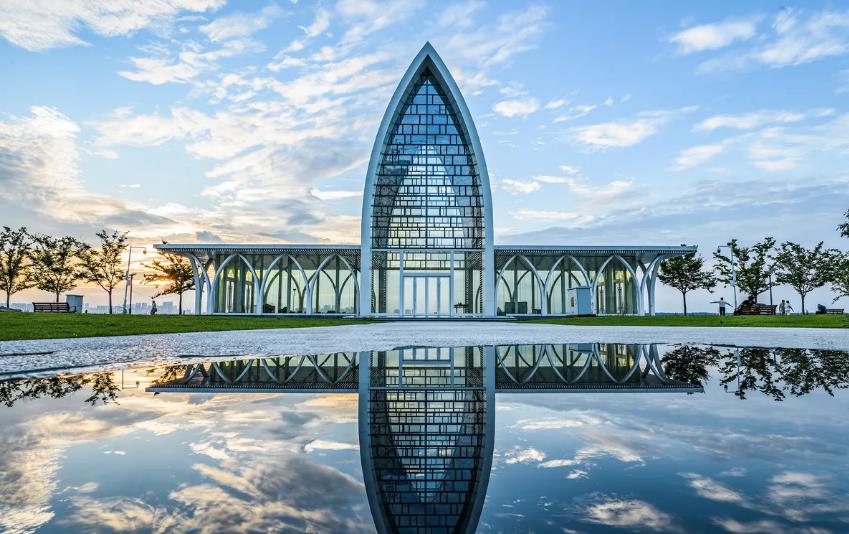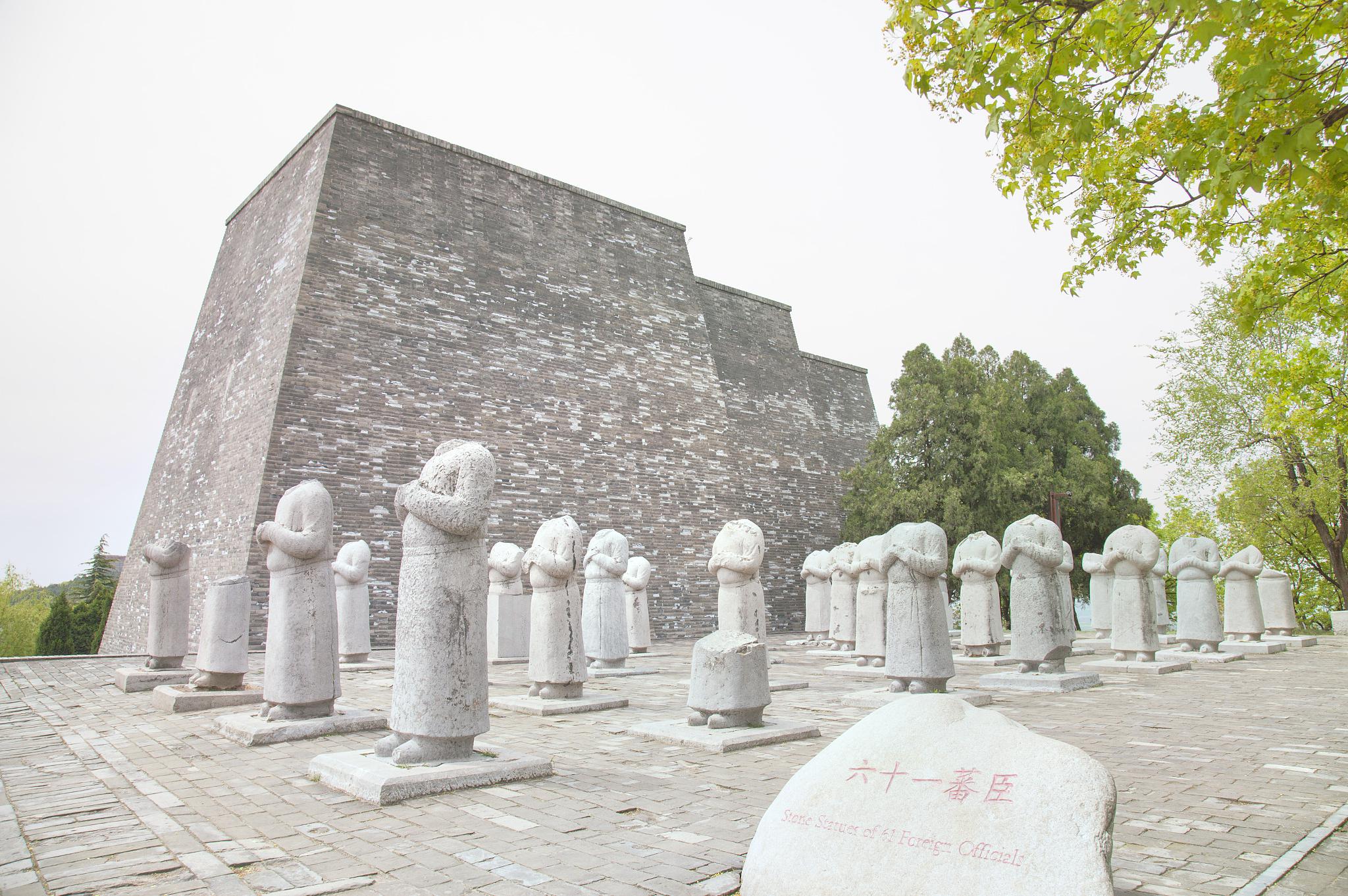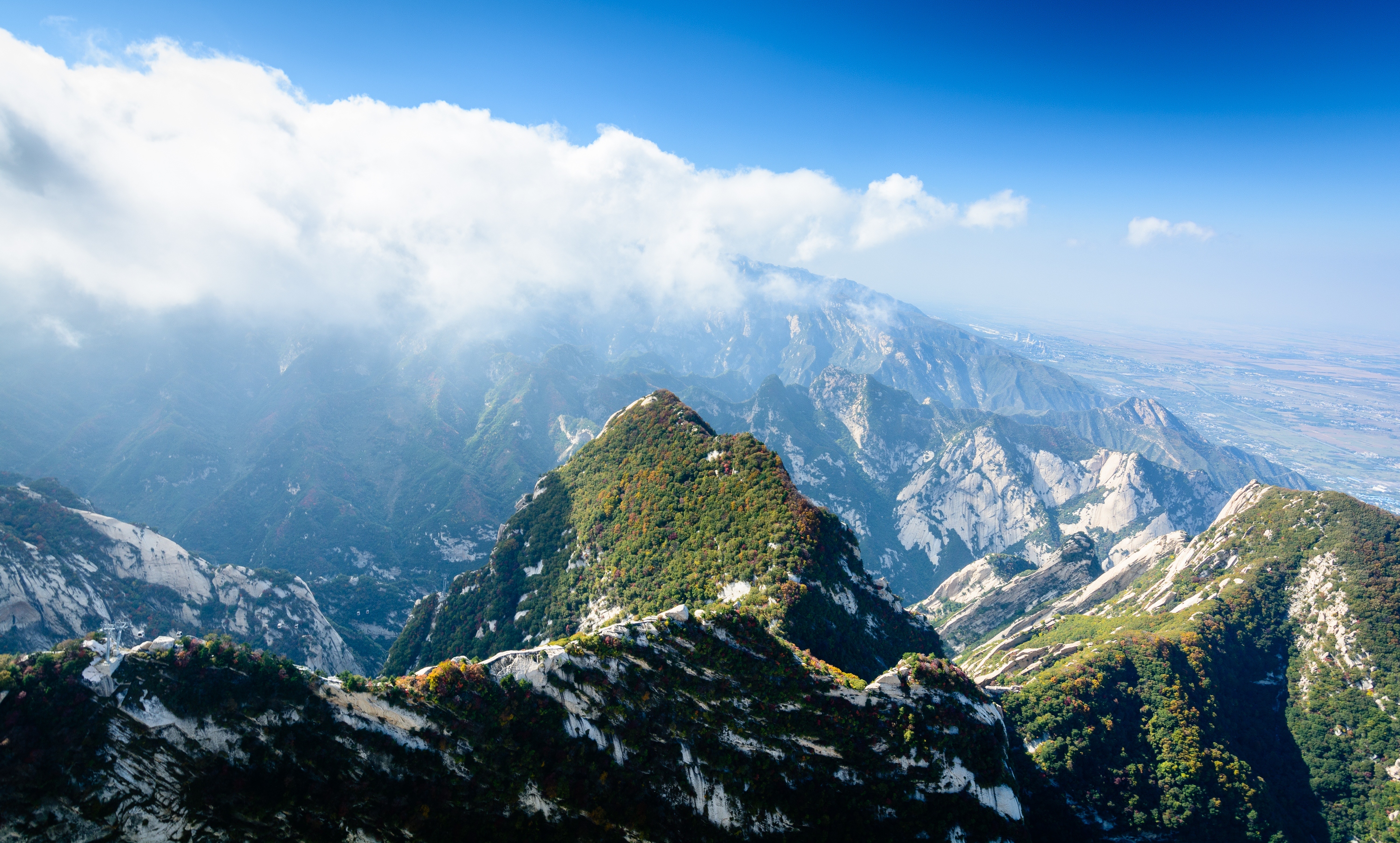https://nz.trip.com/moments/destination-xi-an-7/
2025 Xi'an Travel Guide: Must-see attractions, popular food, hotels, transportation routes (updated in October)
Xi'an, where China's imperial legacy awakens: stand before the Terracotta Army's silent guardians, walk atop Ming Dynasty walls feeling the history, and trace the Silk Road's pulse in bustling Muslim Quarter alleys. This city breathes millennia of dynasties, temples, and trade. Unlock your perfect journey through time with our essential Xi'an guide—from warrior tombs to street-food treasures.
Xi'an Today's weather
Overcast 16-22℃

Trending in Xi'an
Popular Attraction in Xi'an
Grand Tang Mall
(383)Emperor Qinshihuang's Mausoleum Site Museum
(358)Xi'an City Wall
(345)Big Wild Goose Pagoda
(325)Xi'an Bell Tower
(229)Xi'an Muslim Quarter
(212)Shaanxi History Museum
(175)Tang Paradise
(123)Xi'an Drum Tower
(105)Xi'an Museum
(88)Daming Palace National Heritage Park
(43)The Longest Day in Chang'an Theme Block
(39)Xi'an Beilin Museum
(35)Shaanxi Archaeology Museum
(27)Song of Everlasting Sorrow
(25)Xi'an Expo Park
(24)"Tuo Ling Legend" Show
(23)Xi'an Qinling Wildlife Park
(22)THE GREAT QIN
(11)An Army Reborn
(9)All Trip Moments about Xi'an
Xi'an in the Rainy Season – A Green City with Vibrant Flowers
During the rainy season, Xi'an becomes even more lush and refreshing. The trees along the streets and in public parks glisten with rain-soaked leaves, creating a rejuvenating atmosphere. Strolling along the ancient city walls or the park near Yongningmen, you can see raindrops glistening on the leaves and feel the calming embrace of nature. Moreover, flowers along the pathways and in the gardens are in full bloom during this season. Their vibrant colors, contrasting with the gentle rain, add a unique charm to the historic city. It becomes not only a place rich in history but also a perfect spot for taking beautiful photos or enjoying a relaxing cup of tea. Xi'an during this time offers a tranquil and refreshing ambiance, ideal for those who wish to experience both the ancient charm and the vibrant freshness of the city. 🌸✨tpr54 Days 4 Nights In-Depth Xi'an Travel Guide
4 Days 4 Nights Xi'an Travel Guide (Budget 8000 RMB) Trip Highlights: Deeply experience Xi'an's historical culture and feel the charm of the ancient capital. Taste authentic Shaanxi cuisine to satisfy your palate. Comfortable accommodation and convenient transportation for a worry-free trip. Itinerary: Day 1: Arrive in Xi'an, experience the ancient city nightscape Afternoon/Evening: Arrive in Xi'an and check into the hotel. Evening: Head to Muslim Quarter to taste authentic Xi'an snacks such as roujiamo, yangrou paomo, liangpi, etc. Night tour of Bell and Drum Tower Square to enjoy the ancient city night view. Recommended Accommodation: Xi'an Bell Tower Hotel (about 500 RMB/night) Day 2: Travel through millennia, explore the Qin and Tang dynasties' prosperity Morning: Visit the Terracotta Warriors Museum (ticket 120 RMB) to feel the shock of the eighth wonder of the world. Afternoon: Tour Huaqing Palace (ticket 120 RMB), enjoy the beauty of Lishan Mountain, and learn about the love story of Emperor Xuanzong of Tang and Yang Guifei. Evening: Watch the "Song of Everlasting Sorrow" performance (tickets from 268 RMB) to experience the grandeur of the Tang dynasty. Transportation: Private car or tourist shuttle bus (about 200 RMB/person) Day 3: Touch history, savor culture Morning: Visit Shaanxi History Museum (free, reservation required) to learn about Shaanxi's long history and culture. Afternoon: Tour the Big Wild Goose Pagoda (ticket 50 RMB), climb the pagoda for a distant view and feel the Buddhist culture. Evening: Stroll through the Tang Paradise Night Market to experience the culture of the flourishing Tang dynasty and enjoy the light show. Day 4: Ancient city stroll, leisure shopping Morning: Visit Xi'an City Wall (ticket 54 RMB), bike or walk to feel the ancient city style. Afternoon: Head to Yongxingfang to taste more Shaanxi specialties and buy souvenirs. Evening: According to your flight/train schedule, head to the airport/station to end the trip. Other Recommendations: Food: Tongshengxiang Paomo, Defachang Dumplings, Jia San Soup Dumplings Shopping: Shuyuanmen Cultural Street, Luomashi Pedestrian Street Notes: Xi'an is hot in summer, remember sun protection; cold in winter, keep warm. Budget Allocation: Accommodation: 2000 RMB (4 nights) Transportation: 1000 RMB (including airport transfers, private car, etc.) Tickets: 800 RMB Meals: 1500 RMB Shopping and others: 1700 RMB Total: 8000 RMB Warm Tips: The above itinerary is for reference only and can be adjusted according to your situation. Book flights/trains and hotels in advance; prices may rise during peak seasons. Some attractions require advance reservations, such as Shaanxi History Museum. Keep your personal belongings safe and travel securely. Wish you a pleasant trip in Xi'an!jone_456_Mitchell9Xi'an, China
#GetDiscountsWithoutLuck📝 Xi'an Review – A City of History and Ancient Charm: 🏯 Xi'an is China's ancient capital, steeped in history and thousands of years old. 🗿 The Terracotta Army is a must-see. 🚴♂️ Cycling around the ancient city walls is a classic experience. 🌄 The sunset views at the Bell and Drum Towers are breathtaking. 🍜 The long noodles and Xi'an-style food are uniquely delicious. 🕌 The Xi'an Grand Mosque reflects cultural diversity. 🛍️ Muslim Street is filled with food, souvenirs, and local flavors. 🎭 Traditional Chinese folk performances and music offer a deep cultural experience. 📸 Every corner of the city is a photo opportunity, filled with stories and emotions. 💬 The city's people are warm and ready to share their history. 🎁 Xi'an is a destination worth exploring with your heart and curiosity. 📌 Hashtags: #XiAnTrip #VisitXi'an #TerracottaArmy #AncientCityWall #Xi'anFood #MuslimStreet #ChineseCulture #Photography #HistoricalCity #XiAnVibesmoment of pleasure4Defu Lane (德福巷) 🥨 A chill street in Xi'an's old town.
#GetDiscountsWithoutLuck Defu Lane (德福巷) is a small street in the heart of Xi'an, famous for its bars, cafes, and restaurants. The atmosphere blends the antiquity of the ancient city with the modern lifestyle of the new generation. In the evenings and nights, the street becomes especially lively. The decorative lights and live music from the bars create a chill-out vibe unlike any other. In addition to the bars and cafes, there are also local dessert shops and a small hidden tofu pudding shop. This street is not only perfect for partygoers, but also for those looking for a relaxing stroll or a quiet spot to sip coffee or read a book. Defu Lane is another corner of Xi'an that showcases the city's diverse charms all in one place. ✨tpr3Xi'an 1 Day Travel Guide
🏠 Accommodation 1.Ease Hotel · Yi (Xi’an Bell and Drum Tower Xiaozhai Datang Everbright City) 💡 Tips Get to the museum of the Terra-Cotta Warriors as early as possible, book your tickets early and try to go the opposite direction that groups take. Otherwise you will be stuck behind people and get pushed around. It can get pretty crowded in there, even in the morning. Go to the Xian City wall stele forest history culture scenic Area at nighttime and go up the bell tower to have a great view of the city lights and some cool pictures.Adam Bel5How to plan your first trip to Northern Shaanxi?
Don't mess up the itinerary order! Who says Northern Shaanxi is all about sandstorms and cave dwellings? When the first ray of sunlight climbs onto the Danxia patterns of Jingbian's Wave Valley, and the melody of folk songs bursts out from the beats of Ansai waist drums, this land forgotten by time suddenly captures my heart. 🌄 4 Days 3 Nights Northern Shaanxi Itinerary 📅 Day 1: Gather in Xi'an ✈️ Fly into Xi'an, the ancient capital of 13 dynasties, from all over the country ✅ Recommended spots: Bell and Drum Tower night view / Muslim Street snacks (🥩 Must-try: Roujiamo!) ~ 🌊 Day 2: Xi'an - Jingwei Confluence Viewing Platform - Hukou Waterfall - Stay in Yan'an ✔️ Head to Jingwei Confluence Viewing Platform to witness the collision of Jing River and Wei River waters ✔️ Arrive at Hukou Waterfall to experience the roaring grandeur of the Yellow River ✔️ Stay in a Yan'an cave-style homestay 🏨, enjoying the unique warmth in winter and coolness in summer ~ 🎭 Day 3: Yan'an - Wave Valley - Liu Siye Portrait Photography - Northern Shaanxi Intangible Cultural Heritage Storytelling - Stay in Yan'an ✔️ Visit Wave Valley to capture the time-carved Danxia landforms (Outfit suggestion: Red/white for better photos) ✔️ Join Liu Siye's portrait photography session to freeze the rugged stories of Northern Shaanxi's old men ✔️ Listen to intangible cultural heritage storytelling, traveling back in time through the sound of the three-stringed instrument ~ ⛰ Day 4: Yan'an - Ganquan Grand Canyon - Xi'an Departure ✔️ Walk into Ganquan Grand Canyon in the morning, where sunlight forms dreamy beams through the crevices (Best shooting time: 9-11 AM 📸) ✔️ Return to Xi'an afterward, concluding an unforgettable journey on the Loess Plateau ✨ Traveler's Private Tips: ▪ Visit in September-October! The red sandstone glows with metallic luster after heavy rain ▪ Bring a windproof jacket; the plateau's weather changes faster than a face ▪ Learn a few phrases of Northern Shaanxi dialect from locals to unlock hidden warmth1001HW TRIP3Xi An - a place with nature wonders, good food and historical handsome stone statue
#mytraveldiary Xi An is truly remarkable place with good food, historical sites and scenery. Hulu Chicken (葫芦鸡),Xi A style Burger (肉夹馍)are amazing 😋 . Just couldn’t get enough of them. Mount Hua is simply stunning. So is Yellow River Water (母亲河)gushing in Hukou waterfall. Historical sites like Terracotta makes us feel like travelling back in time. For someone who likes historical sites and learning about Great China history, Xi An is the place to visit. Muslim Quarters is a bit too touristy and disappointing though 😝Kingsley Chain3Visit Xi'an, China, a historical city 🇨🇳
#TravelTalk Xi'an 🏮 A historical city with over 3,000 years of history, it's the former capital of ancient China and the starting point of the Silk Road. 🐪 Highlights include the renowned Terracotta Army 🗿, the majestic Xi'an City Wall 🚴♂️, and the magnificent Bell and Drum Towers in the heart of the city. 🏯 There's also the bustling Muslim Street 🍢🥟, filled with a variety of local delicacies. Xi'an is a city that perfectly blends history, culture, and modernity. ✨ Location: Shaanxi Province, China 📍แม๊ววววพาเที่ยววว6Xi'an
#TravelChat Here's a cute, concise review of Xi'an, complete with trendy icons and hashtags: 🏯 Xi'an, a city of living history 🛡️ The magnificent Terracotta Warriors are so spectacular you'll have to stop and watch every action 🌇 Stroll along the old city walls and enjoy the cool evening breeze 🎏 Fluttering red lanterns add to the ancient Chinese atmosphere 🍜 Xiaolongbao and beef noodles are the ultimate indulgence 🕌 The majestic Bell and Drum Towers are breathtakingly beautiful 🌿 The natural scenery surrounding the city is second to none 📸 Take photos from any angle for a #retro-chic feel #XiAnTrip #TravelChinaChic #TerracottaWarriors #EatTravelXi'an #CharmingOldCity #XiaolongbaoIsLife #MustVisitChina #ChibiTravelStylesurang_sae3You can do a lot in 12 hours in Xi’an
I only had 12 hours in Xi’an but I made the most of it. First, I booked a hotel near the city wall so that when I woke up I could easily explore it. The city wall was magnificent. I hired a bike on top of the wall and rode around it. From the exit, I ordered a Didi (taxi) to the pagoda. I also bought a ticket to enter the pagoda. I climbed to the top of the pagoda and was able to get a great view of the courtyard. When in Xi’an, grab yourself a Chinese hamburger (roujiamo - pronounced row - gee - uh - more) and some Biang Biang noodles. You won’t regret eating these foods and you can find them everywhere!AngeKellerman3🍢 Muslim Quarter — Xi’an’s Flavors After Dark
No visit to Xi’an is complete without a walk through the Muslim Quarter (回民街). Just west of the Bell Tower, this maze of lanes is where the city’s Silk Road heritage still thrives — filled with sizzling grills, colorful stalls, and centuries of Hui Muslim culture. A favorite photo stop there is that of a smoking dragon - you won’t missed it as there is always a line queuing ✨ What to Eat • Roujiamo (肉夹馍) — the famous “Chinese hamburger,” stuffed with juicy shredded meat. • Yangrou Paomo (羊肉泡馍) — lamb broth with hand-torn flatbread, rich and hearty. • Liangpi (凉皮) — cool, tangy noodles topped with garlic and chili. • Persimmon Cakes & Pomegranate Juice — sweet street favorites to balance the spice. 🌟 Why Visit? The Muslim Quarter isn’t just food — it’s a living piece of Silk Road culture, where aromas of cumin and chili fill the air, vendors shout their wares, and traditional flavors meet a bustling street atmosphere. 💡 Tips for Visitors • 📍 Located in central Xi’an, a short walk from the Bell Tower. • 🕘 Best time: Evening, when the street is busiest and most vibrant. • 👟 Wear comfortable shoes; it gets crowded. • 🧭 For fewer tourists, explore nearby lanes like Sajinqiao for a more local vibe. #mytraveldiary #chinatravel #xian #muslimquarter #streetfoodchina #silkroadflavors #回民街NatDiscoversAsia4Xi An
Highlights: Xi’an hummed with the weight of dynasties ancient walls, pagodas, and alleyways whispering stories from centuries past. If Wuhan was a river city in motion, Xi’an felt like a deep well: still, resonant, layered with time. We entered through the old city walls, massive and formidable, like the bones of the past holding up the present. Riding bikes along the top was strangely meditative wind in our faces, bell towers rising, city sounds muffled below. The Terracotta Army was everything and nothing like we expected. Thousands of silent warriors, unearthed from red earth, each face unique, their ranks frozen mid-formation. It wasn’t just their scale that impressed, but the eerie sense of purpose as if they were still waiting for an emperor’s command. At the Muslim Quarter, the air buzzed with scent and sound: cumin, chili, lamb sizzling on skewers, the clang of cleavers on wood. We wandered narrow lanes lit by neon signs and hung lanterns, past vendors making hand-pulled noodles in rhythmic stretches. By dusk, the Big Wild Goose Pagoda cast long shadows over wide plazas. Locals danced in the open air, fluid and joyful, while fountains leapt and flickered in time with music. Xi’an held its age with grace not clinging, but carrying.Quinnie_5A must-see when visiting Xi'an! 18 private camera slots + strategies, no need to go wrong📸
#Register for August Hotel Sleep Tester 2025 In many cities, you can do the strategy before you arrive, but Xi'an really needs to do your homework in advance! There are too many ancient buildings and stories here. If you don't want to take a quick look, remember these points 📸【Beautiful Camera Spot】 1. Da Ci En Temple Ruins Park: Navigate the "Tathagata Buddha", do not have to buy tickets to enter the temple, easily get beautiful photos of the Big Wild Goose Pagoda 2. Five Star Street Catholic Church: Turn from Ice Cellar Alley, retro architecture super feel 3. Anyuanmen: Xi'an central axis line must shoot, TV station, bell tower and city wall in the same frame 4. The Ritz-Carlton: Yellow steps with a leafy background for celebrity photos 5. Joy City 4th Floor: Everywhere is the ancient style of the young lady posing with the Big Wild Goose Pagoda, the little bear coffee place is super beautiful 6. Rooftop of the Human Security Building: The Little Wild Goose Tower overlooks the camera position, the view is super wide 7. Ritz Executive Lounge: The perspective of Xi’an’s “Little Manhattan” collides modern and ancient rhyme 8. Roof of Building 1 of Houcun Jiayuan: The Big Wild Goose Pagoda is in the same frame as the TV station, which has a unique sense of screen 9. Overlord Tea Princess 3rd Floor: Bell Tower Photography Excellent Camera, Zero Difficulty to Check In 10. Yongning Gate: Beautiful ancient buildings can be seen everywhere 🍜【Food + Experience Recommendation】 • The Ritz-Carlton: Flame Bamboo Charcoal Grilled Sauce and Grilled Ginseng Must Try! The sea cucumber with sauerkraut topping is surprisingly good; Jing Hin's fried crispy sea bream and sizzling teppanyaki steak are also great • Community Cafe: The door of Zhiyi Coffee is nice and comfortable to sit down and sip a cup of coffee 💡【Tips】 •Shaanlibo: Book your tickets 5 days in advance! It is recommended to watch the documentary first, to enjoy the ancient collection moreKrittkin31Shaanxi: The Home of History and Nature
🏞️ Shaanxi: The Home of History and Nature **Shaanxi**, located in central China, is a travel destination where you can experience ancient Chinese culture. This region harmoniously combines significant historical sites with stunning natural landscapes. Main Attractions 🏯 Terracotta Army: The Terracotta Army is a key historical site showcasing ancient Chinese military culture and architecture, featuring thousands of terracotta warrior statues on display. 🌳 Mount Hua: Mount Hua is one of China's most sacred mountains, where ancient emperors performed rituals. The view from the summit is breathtaking. 🌸 Ancient City of Xi'an: Xi'an was the capital of ancient China and is home to numerous historical relics. Here, you can learn about and experience traditional Chinese culture. 📸 Photography Spots: The Terracotta Army and Mount Hua offer spectacular photo opportunities. Travel Tips 🧳 Packing Essentials: Prepare comfortable hiking shoes and lightweight clothing. If you plan to climb Mount Hua, bring gear suitable for active exploration. 🚶♂️ Transportation: Xi'an has a well-developed public transportation system, making it easy to visit major attractions by bus or subway.미스터량3China's Xi'an: Where Ancient History Meets Adventure
**Xi'an**, the ancient capital of China, is a hub of historical landmarks and ancient culture. Known as the starting point of the "Silk Road," this city is famous for its ancient city walls, tombs, and the world-renowned Terracotta Army. Xi'an offers a unique blend of culture and adventure, providing an opportunity to deeply understand ancient Chinese civilization. 🌟 Highlights of Xi'an Terracotta Army: The most famous site in Xi'an, featuring a massive collection of clay warriors created to guard the tomb of an ancient Chinese emperor. Ancient City Wall: Stretching 14 kilometers, the ancient city wall offers a chance to explore by bike or on foot while enjoying views of the city. Temple of the Big Wild Goose: A historic temple where you can learn about ancient Chinese Buddhist culture and history. Desert Adventures: Near Xi'an, the Yellow River and its surrounding sand dunes provide opportunities for desert exploration and safari experiences. 🕒 Travel Tips Best Time to Visit: Spring and autumn are the ideal seasons to visit Xi'an. Summers can be hot, and winters are cold, so choose a time with moderate temperatures. Transportation: Xi'an is well-connected, and its historical sites are easily accessible by car from the city center. The Terracotta Army, for instance, is about an hour's drive away. Activities: Book tours to explore the ancient city wall by bike or enjoy desert camping near the sand dunes.미스터량5Experience the Great History: Xi'an-Luoyang
#TravelPlanGiveaway 🏛️📝 Xi'an-Luoyang 4-Day, 3-Night Itinerary 📌✅ 🗓️ Day 01: Xi'an✅ 1) 📌 Qin Shi Huang Mausoleum: - 🏛️ A historically significant and magnificent tourist attraction. - 📝 It's best to arrive early in the morning to avoid the crowds. 2) 📌 Xi'an City Wall - 🏛️ A long city wall that encircles the old town. Popular activities include visiting the ancient Chinese costume garden and cycling along the wall. - 📝 It's recommended to visit in the evening. To avoid the sun. 3) 🏨 Accommodation: IU Hotel (Xi'an Guanyin Temple) 🗓️Day 2: Xi'an✅ 1) 🛕 Dacien Temple - Big Wild Goose Pagoda - This thousand-year-old pagoda symbolizes the glory of Buddhism in China. 2) 📍 Muslim Pedestrian Street (Huiminjia: Huimin Street) - Located in the heart of Xi'an, this long street offers a wide variety of Muslim food. 3) 📌 See the Drum Tower and Bell Tower at night. - The lights are beautifully lit at night. The surrounding area is also full of restaurants. 4) 🏨 Accommodation: IU Hotel (Xi'an Qingyuan Temple) 🗓️Day 3: Xi'an-Luoyang✅ 1) 🚅 In the morning, travel from Xi'an to Luoyang by high-speed train. - 🚄 Departure Station: Xi'an North - 🚅 Destination Station: Luoyang Longmen 2) 🛕 Guanlin Temple: - Stop to pray to Guan Yu, the God of Loyalty. 3) 🏛️ Longmen Grottoes: - Another World Heritage Site in China, featuring magnificent cliffs and Buddha statues carved into the rock formations. 4) 🛕 Luoyi Ancient Town: - A bustling ancient city. Inside, there are many shops and restaurants. 5) 🏨 Accommodation: Tuke Qingju Hotel (Luoyang Luoqi Ancient City Cross Street Branch) 🗓️Day 04: Luoyang ✅ 1) ☕ Enjoy delicious, inexpensive local food, such as lamb soup and various hot pot dishes. 2) 🏛️ Lijingmen Gate - An ancient city gate bustling with young people dressed in traditional Chinese clothing. 3) 🏛️ Yingtian Gate - An ancient city gate bustling with young people dressed in traditional Chinese clothing. 4) 🛕 Sui and Tang National Heritage Park - Well worth a visit to learn about its fascinating history. 5) Return to Xi'an by high-speed train. #Xi'an #TravelChina #Luoyang #TravelChinaByYourselfKornna Gonna Go11Experience the grandeur of Chang'an in one night at Tang Paradise, truly not to be missed
This is the most beautiful night view in Xi'an! When the lights are bright, it feels like traveling back a thousand years to the Tang Dynasty's golden age~ By day it's Xi'an, by night it's Chang'an, switch time and space with one click!✨ 🚕Navigation: Tang Paradise 📍Location: No. 46 Ci'en Road, Yanta District, Xi'an, Shaanxi Province 🕰️Opening Hours: All day (Performances 19:00-22:40) 🚇Transport: Metro Line 3/4 to Dayanta Station, Exit B/C 🌟🌟🌟【Golden Tour Route Guide】🌟🌟🌟 【Start】North Square of Big Wild Goose Pagoda ✨19:00 Fountain show starts on time (Asia's largest musical fountain!) ✨Recommended to arrive early to get a good spot ➡️【First Stop】Ancient Poetry Street Stroll through the brightly lit poetry corridor and feel the romance of the ancients💕 Photo rating: 📸📸📸📸📸 ➡️【Second Stop】Statue of Xuanzang The statue of Xuanzang under the 1300-year-old Big Wild Goose Pagoda Cultural rating: 🏯🏯🏯🏯 ➡️【Third Stop】Kaiyuan Square Don't forget to look up and enjoy the stunning light show! Shock rating: ✨✨✨✨✨ 🎭🎭🎭【Must-See Spectacular Performances】🎭🎭🎭 19:15-19:40 Tumbler Girl (Wu Hou Walk, south side of the sculpture) 20:00-20:10 Tang Dynasty Secret Box (west side of Defachang) 20:10-20:20 Tang Dynasty Wedding (east side of Zhenguan Governance sculpture) 21:10-21:30 Return to Chang'an (Main stage at Kaiyuan Square) 21:30-22:30 Float Parade (throughout the street) 🍜【Foodie Spots】 🌟Yintai 3rd Floor Yuanjia Village Affordable and authentic! Must-try: Donkey Hoof Noodles|Roujiamo (Chinese burger)|Biangbiang noodles Average cost: 15-25 RMB to fill up! 🌟Shan Shi San For the adventurous: Oil-splashed chili ice cream🍦 Recommended to order the double flavor~ 🏠【Accommodation Recommendation】 Backpack Ten Years Youth Hostel (Bell Tower Branch) 🚇3 minutes from the metro station 💰Great value for money Recommended spot for night views! 💡Travel Tips: 1. Recommended to arrive around 18:00, lighting is perfect for photos 2. Remember to wear comfortable shoes, the whole trip takes 2-3 hours 3. Performance times may change, please check in advanceThe Culinary Wayfarer3Xi'an 2 days 1 night tour
#TravelPlanGiveaway 🏛️Xi'an 2-Day, 1-Night Trip Plan📚 ❤️This itinerary is recommended for those with limited time❤️ Day 01: 1) 📌 Qin Shi Huang Mausoleum: - 🏛️ A historically significant and magnificent tourist attraction. - 📝 It's best to arrive early in the morning to avoid the crowds. 2) 📌 Xi'an City Wall - 🏛️ A long city wall that encircles the old town. Popular activities include visiting the traditional Chinese clothing garden and cycling along the city wall. - 📝 It's recommended to visit in the evening to avoid the sun. Day 02: 1) Dacien Temple - Big Wild Goose Pagoda - This thousand-year-old pagoda symbolizes the glory of Buddhism in China. 2) 📍 Muslim Pedestrian Street (Huiminjia: 回民街) - Located in the heart of Xi'an. It's a long street with a wide variety of Muslim food stalls. 3) 📌See the Drum Tower and Bell Tower at Night - At night, the lights are beautifully lit, and the surrounding area is full of restaurants. #TravelChinaByYourself #TravelChina #Xi'anTravel #Xi'anKornna Gonna Go3One person can travel to Xi'an for 3 days with a budget of 5,500 baht.
(Traveling in July 2025) For this trip, we opted for a leisurely, unhurried trip to Xi'an, focusing on exploring the historic city center and its beautiful architecture. We started with the Bell and Drum Towers, a prominent landmark, and continued on to walk along the intact ancient city walls, offering panoramic views of the city. We then visited temples and sacred sites, including the highlight, the Mausoleum of Emperor Qin Shi Huang, where we witnessed the mighty Terracotta Army. The food was equally impressive. Muslim Street was a foodie paradise, filled with the aromas of grilled meats, spices, and local snacks. The night market was bustling, offering a chance to try dishes we'd never seen before, a unique attraction in Xi'an. This was my first solo trip in China, and I must say, I enjoyed it and learned a lot. Having time to myself, walking around the city, eating, and exploring without having to follow anyone gave me a sense of freedom. I must say, China is much safer than I thought, with clean roads and convenient transportation. Total cost: approximately 5,512 baht ✈️ Round-trip airfare: 2,570 baht 🍷 Miracle Lounge: 0 baht (free access due to trip.com Platinum upgrade) 🛏️ 3-night stay at Desti Youth Park Hostel (Bell Tower area): 788 baht 📶 Chinese SIM card (1GB/day x 3 days): 109 baht 🚇 City transportation (subway/bus): 72 yuan ≈ 350 baht 🍜 Food and drink: 256 yuan ≈ 1,240 baht 🏺 Mausoleum of the First Qin Emperor: 120 yuan ≈ 455 baht #Xian #XianTravel #SoloTravelChina #TravelChina #TravelBudgetShareAommon10Xi'an Wolong Temple: The Spiritual Palace of the First Zen Temple in Northwest China
Nestled in a tranquil valley at the foot of Mount Zhongnan, Wolong Temple in Xi'an exudes a tranquil and tranquil Zen atmosphere amidst lush greenery. Founded during the reign of Emperor Ling of the Eastern Han Dynasty (approximately 168-189 AD), this ancient temple was originally named "Fuying Zen Temple." During the Tang Dynasty, it was known as "Guanyin Temple" due to the enshrinement of a Guanyin statue by Wu Daozi and its emphasis on Pure Land Buddhism. The Song Dynasty monk Weiguo, known for his long years of meditation at the temple, led Emperor Taizong of Song to change the name to "Wolong Temple," marking its transition from Pure Land Buddhism to a Zen Buddhist monastery. Wolong Temple, a rare large-scale Buddhist monastery in Northwest China, integrates the practice of Linji Zen meditation with cultural preservation. Preserving precious Buddhist relics such as the Tang Dynasty Buddha's Footprint Stele, the Southern Song Dynasty Tripitaka (Jishazang), and ancient Indian palm-leaf manuscripts, Wolong Temple boasts a rich cultural heritage. During the reign of Emperor Guangxu of the Qing Dynasty, Empress Dowager Cixi, seeking refuge in Xi'an, donated a thousand taels of silver to rebuild this ancient temple. She personally inscribed the plaque "Imperially Built the Ten Directions Wolong Zen Temple," granting it imperial status. On a balmy summer morning, a gentle breeze blew as our group of five entered Wolong Temple. Following the bluestone path, weaving through the shade of ancient trees, the sounds of morning bells and drums drifted closer and closer, each one pleasing to the ear. The melodious chants of Buddhist scriptures flowed in unison as monks and laypeople chanted sutras, the sound of the Dharma flowing like a spring. Each recitation, like a gentle breeze, cleansed our minds of impure thoughts, allowing us to reflect on our true nature and find joy and freedom. The buildings of Wolong Temple, folded and winding along the mountainside, resemble a giant dragon lying amidst the verdant hills. Entering through the mountain gate, one is greeted by gray brick and red walls, shaded by ancient cypresses. In order, one can see the Heavenly King Hall, Guanyin Hall, Great Compassion Hall, Main Hall, Sutra Library, and Dharma Hall. These halls, arranged in an orderly pattern along the central axis, gradually rise from low to high. Walking through them, one feels as if entering a tranquil and pure land, far away from the hustle and bustle of the world, a moment of detachment. Looking up at the mottled stone walls, it feels as if past wounds and present anxieties can be healed here. Leaving Wolong Temple, we exchanged a silent smile, as if we both understood: pilgrimage is not a journey, but a return to our original aspirations within the familiarity of life. #Shifang Zen Forest #First Zen Forest in Northwest China #Linji Sect #Zen #Spirit of Zen #Spiritual Healing Attractions #Buddhist Architectural Aesthetics #Spatial Art悦冬3Xi'an Metro for just 6 yuan
✅ Stop ❶: Gudulang Bridge Exit D of Baimahe Station on Metro Line 1. Walk 800 meters to reach the bridge. Enjoy the shimmering waters of Xianyang Lake and the refreshing breeze—perfect for daydreaming! You can also try boating or speedboating on the lake if you're up for some fun. ✅ Stop ❷: Wenmiao (Confucian Temple) A 200-meter walk from Gudulang Bridge. It feels like stepping into a traditional Chinese ink painting. Every photo here is Instagram-worthy, especially for fans of ancient Chinese aesthetics. ✅ Stop ❸: Phoenix Terrace/Anguo Temple A 10-minute walk from Wenmiao. Along the way, you'll pass Beiping Street, which is lined with charming little shops. Don't miss the iconic "Xianyang" wall for a photo op! ✅ Stop ❹: Qingwei Tower Another 10-minute walk along the old street. This historic tower is as famous as Yellow Crane Tower and Yueyang Tower. Climb up for a stunning panoramic view. ✅ Stop ❺: Fuyuan Alley Take Bus 56 directly from Qingwei Tower's entrance. This alley is a haven for Shaanxi's local delicacies: cold noodles, roujiamo (Chinese burger), zenggao (steamed rice cake), stir-fried cold noodles, and more. Authentic flavors at budget-friendly prices—just 10 yuan for a hearty meal!PINK66617Unbelievable! Hidden near the Giant Wild Goose Pagoda is such a stunning hotel
It's so beautiful it could make you cry, tucked away in the pagoda square! You won't believe it until you see it—this hotel is absolutely breathtaking... Step onto the hotel terrace, and the Giant Wild Goose Pagoda view unfolds before your eyes. The serene environment and lush courtyard greenery create a tranquil oasis. Savoring afternoon tea here makes all your worries melt away. Their Tang-style confections are masterpieces, each piece a work of art. Not only are they visually stunning, but the texture is also velvety smooth. Light and not overly sweet, handmade from white kidney beans with no additives—perfect for all ages. Every corner of this hotel is Instagram-worthy, a photographer’s dream. The afternoon tea is both exquisite and delicious 😋, and you can enjoy a drink or two in the evening. This blissful retreat is nestled in the Great Tang All Day Mall pedestrian street, just a 5️⃣-minute walk from the subway 🚇, making it super convenient to explore everywhere.IneffableEffervescentNebula13Mehood Lizi Hotel|Unlock an Exceptional Stay Experience
Hey everyone 👋, I recently discovered an amazing hotel — Mehood Lizi Hotel (Xi'an Kaiyuanmen Metro Station & Xidian Group Hospital Branch), and I just have to share it with you! 📍Location The hotel's location is absolutely perfect, right at the intersection of Metro Line 1 and Line 8 (Kaiyuanmen Station) 🚇. Whether you're heading to popular attractions like the Bell and Drum Towers or the Giant Wild Goose Pagoda, or exploring bustling commercial districts, the metro makes everything easily accessible. With a well-developed transportation network nearby, the hotel is just a short walk from the metro station, making it super convenient to reach every corner of the city 🚌. 🛏Room Ambience The moment I stepped into the room, the modern, lightly luxurious decor instantly caught my eye ✨—simple yet exuding quality and style. The room is fully equipped with high-tech amenities like a smart toilet 🚽, Xiaodu voice-controlled system 🤖, and a 65-inch TV with phone screen mirroring 📱. The bedding is exceptional, featuring memory foam and down pillows 💤, plus a mattress that's soft yet supportive, ensuring a restful sleep every night. Some rooms even come with a private open-air courtyard 🏡—just open the window to enjoy a relaxing time. Other rooms have large windows that let in plenty of natural light 🌞, offering expansive views of the cityscape 🌆. 💁♀Service Quality I have to rave about their service! From the moment I entered the hotel, the front desk staff greeted me warmly 🙋♀, and the check-in process was efficient and thoughtful. Throughout my stay, thoughtful touches kept coming: a late-night bowl of noodles 🍜 to warm your stomach, an elegant afternoon tea ☕ to sweeten your day, hot towels for freshening up 🧖, and chilled spring water upon departure 🧊—every detail reflects their care. They even provide welcome fruits 🍎, making you feel valued the moment you step into your room. 🍽Dining Experience The hotel's breakfast spread is diverse, featuring both local Xi'an specialties like Qishan minced noodles 🍜 and a variety of Western options 🥐, catering to all tastes. The restaurant's ambiance is elegant and cozy, with soft lighting 💡 and tidy seating, making breakfast a truly pleasant experience. 💰Value for Money Among hotels of the same tier, Mehood Lizi Hotel (Xi'an Kaiyuanmen Metro Station & Xidian Group Hospital Branch) offers unbeatable value 💯. With reasonable prices 💰, it delivers high-quality service, a comfortable stay, and a rich dining experience—truly worth every penny! In short, Mehood Lizi Hotel left me thoroughly impressed, and I highly recommend it to everyone! Next time you're in Xi'an, consider staying here 💕!MovieBuffLover#3Hotel
This stay was at the Qindu Legend voco Hotel under the InterContinental Hotels Group, blending fashion, trendiness, and personalization into one. Upon entering, you're greeted with a visual reminiscent of an American Vanity Fair scene—vibrant color clashes, yellow sofas, adorable bear-shaped chairs, and even a custom-branded voco Mercedes-Benz Smart car and a stylish scooter at the entrance, adding a playful, energetic vibe to the space. The perfect fusion of modernity and elegance, with marble floors reflecting stunning light effects, exudes a strong sense of understated luxury. The stay was exceptional, with the rooms being particularly refined. Spacious and thoughtfully designed with functional zones, they feature large bathtubs, Dyson hair dryers, and full smart amenities—controlling lights and curtains from bed adds a tech-savvy touch. The view outside the window is expansive, and the seafood buffet delivers both quality and innovation, offering a rich variety to satisfy every palate.AuroraMystic7893📚 Shaanxi Provincial Library – Xi’an’s Historic Cultural Hub
#chinatravel 🚇 How to Get There • Chang’an Road Library: Near Xian Stadium Station (Line 2, Exit B) or multiple bus routes (e.g. 12, 31, 215, 630) to Provincial Stadium  🏛️ Why Visit? • One of China’s first provincial public libraries, with rich collections and over a century of history • Part of the National First‑Class Library system, with over 5.5 million volumes, including rare books and local heritage archives #chinatravel #travelchina #china #travel #malaysiatochina #myitinerary #familytravel #chinatrip #xian #西安Joyous Fun8My spending philosophy collapsed after 3 days in Xi'an
1. Top 3 Must-Visit Attractions 🔥【Terracotta Army of Qin Shi Huang】The Eighth Wonder of the World ✔️Incredible live experience! The grandeur of Pit 1’s military formation is breathtaking, AR glasses take you back to the Qin Dynasty💫 📍Qinling North Road, Lintong District ⏰08:00-19:30 (Recommended to go right when it opens) 💡Tips: Plenty of parking for self-driving | Rent AR glasses if with kids | Avoid weekend crowds 🌟Visitor rating: 4.1 ("Easy parking", "Perfect for family trips") 🌃【Tang Paradise Night City】24-hour free carnival ✔️The night light show is stunning! The "Tumbler Girl" interaction is super fun 📍46 Ci'en Road, Yanta District 💡Photo tips: Less crowded before 7 PM | Wearing Hanfu makes photos pop | Nearby Yintai Mall for dinner 📸Popular spots: "Secrets of the Tang Dynasty" show | Poetry lantern corridor 🌟Over 444,000 check-ins: "Top spot for couples" and "Full immersion in history" 🏰【Xi'an City Wall】Cycling to watch the sunset is amazing! ✔️The most complete ancient city wall in China | 13.7 km cycling is thrilling 💡Practical tips: Bike rental at Yongning Gate/Hanguang Gate | 45 RMB/3 hours | Sunset views are breathtaking 🌟Visitor review: "Cycling experience is legendary! Full of historical vibes" 2. Accommodation Guide (with bonus tips) 1⃣️【Bell and Drum Tower Area】King of nightlife ✨Yunhe Night Stay: Butler service + intangible cultural heritage experience (4.9 rating) ✨Pai Hotel: Smart toilets + excellent location (4.5 rating) 💯Best for: First-time visitors to Xi'an/night market lovers 2⃣️【Big Wild Goose Pagoda Core Area】Must-stay for culture lovers ✨The Westin Hotel: Relax with a view of the Big Wild Goose Pagoda (4.7 rating) ✨Xitang Hotel: Free Hanfu experience (4.7 rating) 📸Photo tip: Executive lounge with scenic views 3⃣️【Qujiang New District】Exclusive for high-end travelers ✨Shengmeiliya: Tang Dynasty style + Spanish fusion (lake view is stunning) 🍵Afternoon tea: Essential for Hanfu photoshoots 3. Money-saving Transportation Tips ✈️Airport: Line 14 direct | Taxi about 70 RMB 🚅High-speed rail bonus: Line 2 gets you to Bell Tower in 30 minutes 🚌City transport: Metro day pass 15 RMB unlimited rides | Bus 306 direct to Terracotta Army ⚠️Avoid: Don’t take taxis during rush hour! Ride-hailing apps are more reliable 4. Local Hidden Food Gems 【Must-eat list】 • Ma Zhangsheng’s Fatty Steamed Cake: 5 RMB small portion, always a favorite • Ziwu Road Zhang’s: The ultimate Roujiamo (meat sandwich) for 12 RMB • Zhang Ling Spicy Hot Pot: Secret sauce sells 1,500 bowls daily • Bell Tower Neighborhood Belt Noodles: Noodles wider than a belt 【Food map】 Muslim Quarter bonus: Dive into Dapiyuan to find "Ma Hong Paomo" Yongxingfang must-buy: Adorable brush pen pastries! Sajin Bridge king: Liu Xin’s Paomo is legendary 5. Top Cultural Experiences 🎭Intangible cultural heritage exclusives: • Gao Family Courtyard Huayin Laoqiang opera (30 RMB, totally worth it!) • Yisu Society Qin Opera experience (weekends only) • Shadow puppetry DIY (even beginners can enjoy) 🌸Festival highlights: Spring Festival City Wall Lantern Fair | Mid-Autumn Hanfu Lantern Garden Tour September Pomegranate Festival (free food!) 6. Lazy Traveler’s Route Plan 🌟3-day highlights: Day 1 Terracotta Army → The Song of Everlasting Sorrow → Muslim Quarter Day 2 Shaanxi History Museum → Big Wild Goose Pagoda → Night City Day 3 City Wall cycling → Yongxingfang 💎5-day deep tour: + Famen Temple / Mount Hua / Hanyang Mausoleum (for time management pros) ⚠️Ultimate tips: • Book Shaanxi History Museum tickets 3 days in advance! • Learn the local phrase "liao za lie" to instantly blend in • Best seasons: April-May / September-October 🌈The romance of this ancient capital is all hidden in this guide! Take it with you and start your time-travel adventure✨WYATT RODRIGUEZ21Tired of the usual Xi'an travel guides? Check out this mind-blowing new guide!
Xi'an 3 Days 2 Nights History & Food Tour🔥 This ancient capital of 13 dynasties is basically my happy hometown! Plan your route wisely to enjoy millennia-old culture and feast through Huimin Street~ 🚶♀️Itinerary Day 1: 📍Terracotta Army of Emperor Qin Shi Huang: The eighth wonder of the world, a must-visit! It's recommended to hire a guide; the stories of these sleeping warriors are truly breathtaking (Address: Qinling North Road, Lintong District) 📍Huaqing Palace: The place where Yang Guifei bathed, with an amazing "Song of Everlasting Sorrow" performance at night 📍Huimin Street: Dinner here! Try the red willow kebabs and Lao Sun's paomo until you can barely walk Day 2: 📍Shaanxi History Museum: Free but very hard to get tickets! Book 3 days in advance (closed on Mondays) 📍Giant Wild Goose Pagoda: The place where Xuanzang translated scriptures, the music fountain at the North Square is stunning at night 📍Tang Paradise: Instantly transport yourself to the prosperous Tang Dynasty, the roly-poly girl is right here Day 3: 📍City Wall Cycling: Enter from Yongning Gate, rent a bike to circle the city wall—super cool (Ticket 54 RMB) 📍Shuyuanmen: A must-visit for artsy youth, home to many traditional stationery shops 📍Bell and Drum Towers: Iconic buildings with beautiful night views, free check-in at Kaiyuan Shopping Mall observation deck 🍜Food Guide ✅Roujiamo (Chinese burger): Recommended Qin Yu Roujiamo main store, crispy bun and fragrant meat ✅Liangpi (cold noodles): Wei's Liangpi with sesame sauce is amazing ✅Persimmon Cake: Freshly fried and super sweet at Lao Bai's on Huimin Street ⚠️Practical Tips 1. The "Xi'an Electronic Metro Card" is super convenient for scanning on the subway 2. Don’t talk to unlicensed guides at the Terracotta Army; official guides are reliable 3. You can buy a 30 RMB Treasure Hall ticket at Shaanxi History Museum to skip the line 4. Visit the city wall at dusk to catch the sunset and avoid the sun@rch0n_Ph03n1x3🏯Xi'an Terracotta Warriors: A World Wonder Journey🗿
#chinatravel It is the largest imperial burial pit in Chinese history. Each terracotta warrior has a unique face and costume, vividly recreating the organization and equipment of the Qin Dynasty army. Advantages: As a world cultural heritage, its historical and archaeological value is irreplaceable; the scenic area provides multilingual smart guides (rental 30 yuan), and the explanations include the latest archaeological discoveries. Disadvantages: The main pit tour route is a one-way loop, and it is difficult to stop and take a closer look during the peak season; the surrounding farmhouses mostly use "Terracotta Warriors Special Meals" as a gimmick, the price is inflated and the taste is average. Notes: It is recommended to combine the Qin Shihuang Mausoleum Lishan Park tour (included in the joint ticket), and take the scenic area's free shuttle bus to and from; enter the park before 9 am to avoid the peak of tour groups; flash photography is prohibited in the museum, which will damage the surface of the terracotta warriors.TravelwithAGE32

Popular Xi'an topics

2025 Recommended Guides in Xi'an (Updated October)
7170 posts

2025 Recommended Attraction in Xi'an (Updated October)
5006 posts

2025 Recommended Hotels in Xi'an (Updated October)
2538 posts

Destinations related to Xi'an

2025 Xianyang Travel Guide: Must-see attractions, popular food, hotels, transportation routes (updated in October)
171 posts

2025 Yan'an Travel Guide: Must-see attractions, popular food, hotels, transportation routes (updated in October)
137 posts

2025 Mount Hua Travel Guide: Must-see attractions, popular food, hotels, transportation routes (updated in October)
31 posts
- 1
- 2
- 3
- 4
- 100
Post
More recommendations
Popular Trip Moments
Hotel Highlights: Great Location & Lovely Self-Service Laundry | Xi'an Terracotta Warriors and Horses Exhibition Travel Guide🌧 | Warm and cozy residences in the ancient capital Xi 'an🛏️ | Xi'an Forest of Steles: A pilgrimage site for calligraphy enthusiasts | Shanxi Off-Season Travel Guide | What hotel to stay at in Xi'an? Then you've come to the right person | Staying next to the Bell Tower in Xi’an is a hot topic! This Pai Hotel’s cost performance is truly legendary | The Ceiling of Qinling's Autumn | Students are so excited they cried, if you come to Xi'an, you must stay at this hotel! | travel happiness ✨ | A Dream of Chang'an with a View of the Pagoda from the Window | 6 Days 4 Nights Exploring the Historical Land of Xi'an, China | Attractions around Xi'an Railway Station: Tang Paradise, Big Wild Goose Pagoda Area | lyf Dayanta Xi’an: A Hidden Gem You’ll Never Want to Leave! | Big Wild Goose Pagoda, Daci'en Temple, Xi'an | Retracing history @ Xi'an City Wall | Walking through thirteen dynasties! Xi'an 4 days 3 nights immersive guide for foodies + history buffs must rush | Xi'an's Top 8 Mid-Autumn Festival Destinations | Tang Paradise Nights🌃 | The City Center of Xi’an 🏙️✨ | History Walk with the Terracotta Army, Xi’an 🏺🇨🇳 | The Terracotta Army that everyone in the world wants to see | Xi'an Qiyue, a cozy nest nestled in history | Reverse National Day Travel Guide: 3 Days from Xi'an to Explore the Misty Wonderland of Han River, Few People and Beautiful Scenery
Recommended Attractions at Popular Destinations
Popular Attractions in Los Angeles | Popular Attractions in Sydney | Popular Attractions in West Lake | Popular Attractions in Las Vegas | Popular Attractions in Tokyo | Popular Attractions in Kuala Lumpur | Popular Attractions in Singapore | Popular Attractions in Walt Disney World Resort | Popular Attractions in Bali | Popular Attractions in Bangkok | Popular Attractions in New York | Popular Attractions in Paris | Popular Attractions in Rome | Popular Attractions in Osaka | Popular Attractions in Dubai | Popular Attractions in Kyoto | Popular Attractions in Phuket | Popular Attractions in Barcelona | Popular Attractions in Chefchaouene | Popular Attractions in Zanzibar Island | Popular Attractions in Melbourne | Popular Attractions in Shanghai | Popular Attractions in Iguazu National Park(Argentina) | Popular Attractions in Beijing | Popular Attractions in London | Popular Attractions in Madrid | Popular Attractions in Florence | Popular Attractions in Chengdu | Popular Attractions in Jungfrau Region | Popular Attractions in Istanbul
Popular Restaurants in Xi'an
MAPLE HOUSE | YEN | Tasuro | Guoyuanzhailaomijia(beiguangjijiedian) | WEI JIA | Hu Pan | Cai Feng Lou Chinese Restaurant | Laobaijia Shuipen Mutton | Fan Ji La Zhi Rou(ZhuBaShi) | CLUB CHANG AN | JING XUAN | Tian FaYa | Tang Dynasty Art Garden Hotel Xi'an Shanxi Guan Fu Cuisine | The Fifty · seven | CHAR | B&G51 RESTAURANT AND BAR | 西安华清御汤酒店·御膳苑 | JIANG CHENG XIAO GUAN | CHANG'AN BRIDGE | XIAO CHANGAN | JIANG CHENG XIAO GUAN | CHANG'AN BRIDGE | Chun FaSheng Restaurant (Nan YuanMen dian) | XI'AN RESTAURANT | GUO LAO SAN MIAN ZHUANG | LOTUS | 毅祥斋老孙家泡馍(西羊市店) | Ma hong xiao chao pao mo guan(hui min jie dian) | DACHUXIAOGUAN | LE CHINOIS
Popular Ranked Lists
Top 50 Must-Visit Restaurants in Macau | Top 50 Must-Visit Restaurants in Jeju | Popular Trending Attractions in Wuyuan | Top 10 Trending Attractions in Nanjing | Top 50 Luxury Hotels near Dover | Top 50 Must-Visit Restaurants in Xi'an | Top 50 Must-Visit Restaurants in Madrid | Popular Premium Hotels in Noizay | Popular Premium Hotels in Veliko Tarnovo Province | Popular Premium Hotels in Bacacay | Popular Trending Attractions in Dali | Popular Trending Attractions in Los Angeles | Top 10 Trending Attractions in Shenzhen | Top 50 Must-Visit Restaurants in Songyang | Top 10 Trending Attractions in Harbin | Popular Trending Attractions in Hefei | Popular Premium Hotels in Guatape | Popular Premium Hotels in Palau | Top 10 Trending Attractions in Tokyo | Popular Trending Attractions in Shaoxing | Popular Premium Hotels in Samoens | Popular Premium Hotels in Sala Comacina | Popular Trending Attractions in London | Top 10 Trending Attractions in Changchun | Top 50 Must-Visit Restaurants in Auckland | Top 20 Luxury Hotels near Rybnik | Top 50 Must-Visit Restaurants in Ho Chi Minh City | Top 10 Trending Attractions in Yangzhou | Top 10 Trending Attractions in Hong Kong | Top 10 Trending Attractions in Dalian
About
Payment methods
Our partners
Copyright © 2025 Trip.com Travel Singapore Pte. Ltd. All rights reserved
Site Operator: Trip.com Travel Singapore Pte. Ltd.
Site Operator: Trip.com Travel Singapore Pte. Ltd.